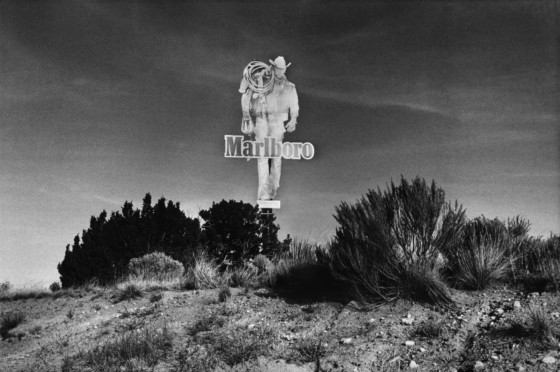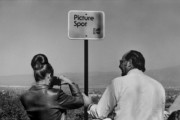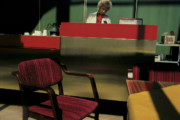The American Desert: an Elegy to Friendship
Raymond Depardon’s meditations on friendship, loss, and the value of image-making are a cinematic take on the personal diary
America’s open roads have inspired countless artists and writers, the expansive landscapes, the empty highways, roadside attractions, pit stops, the passing ghost towns, as significant, if not more so, than the eventual destination. This summer on Magnum Photos, we explore the American road trips made by Magnum photographers in order to understand why the idea of road tripping across America has captured the imagination of so many: this article inspired by Raymond Depardon‘s book Le Desert Americain is part of our On the Road series.
The above image from Los Angeles is available now as a Magnum Editions Poster. Shop them all here.
Raymond Depardon made three trips across America during 1982; the second trip was with close friend and colleague Olivier Froux, and the third, made after Froux’s death in that same year was something of a cathartic exercise.
“This was a mourning, a solitary journey, during which he followed the footsteps they had trodden together, a few weeks earlier, for Olivier’s first trip to the land of images: Los Angeles, Death Valley, John Ford Canyons, the beginning of the desert, Mexico,” wrote Serge Toubiana, a mutual friend of Depardon and Froux, in the foreword to Depardon’s book The American Desert. It comprises an edit of photographs taken that year, mostly driving across the empty expanses of America’s open highways. With the American landscape as background, the book celebrates Depardon and Froux’s friendship, and their shared love for image-making.
"I would like to be alone and think / everything happened so fast / I don’t want to look for a replacement / I know I will have to make this film one day. (…) Olivier was more than an editor! "
- Raymond Depardon
Raymond Depardon and Olivier Froux made three films together, Numéros Zéro, Reporters and Sam Clemente. Working as Depardon’s editor, Olivier participated greatly in the process, making these films the result of thoughtful negotiations with the French photographer. “Our evolution, Olivier and mine. It seemed natural after three films made together, he had an influence on me,” wrote Raymond Depardon in The American Desert.
“He knew he might be wrong, and he wanted to process things slowly, question himself along the way. He was always searching for something. He believed in the film, listened to advice, could be influenced, then sometimes, stopped, because he knew he had found the right direction to follow. Because he wanted to improve the film constantly, this process could last 15 days or even more than a year. But, time was limited and he knew that sooner or later, he would have to stop. The film would be finished. We could have no regrets. He would have done the maximum,” he continues.
The sudden loss of his editor was a heartbreaking experience, which Depardon sought to escape by making his third trip to America. “I would like to be alone and think / everything happened so fast / I don’t want to look for a replacement / I know I will have to make this film one day. (…) Olivier was more than an editor!” he wrote.
Conceived in the manner of a diary, The American Desert contrasts Depardon’s photographs with his personal notes. His musings serve as captions to the images, creating a narrative that connects the visual sequence. The reading of the photographs of empty, natural or urban landscapes are shaped by Depardon’s words and memories of his conversations with Froux.
"There are a few subjects I still wish to make. Will I still want to do them? Will I make others?"
- Raymond Depardon
Also a filmmaker, even in his photography, Raymond Depardon captures a mood that feels cinematic in the complexity of emotions it conjures. “It is within this unfixed moment, within space and time, in the desert, on a road at night – which looks like the dark images passing on the screen of an editing table, but most of all an interior space, that Raymond Depardon photographer became once again filmmaker,” wrote Toubiana.
Here, we present images taken by Depardon on his 1982 American trips with their original captions. Empty roads, and expansive desert vistas feature prominently, interrupted by dimly lit scenes in lonely roadside motels, and small towns that punctuate the route.
"Our evolution, Olivier and mine. It seemed natural that after three films made together, he had an influence on me. "
- Raymond Depardon
Through the photographer’s camera and pen, we explore the American West and Eastern coasts in the 80s, and witness the photographer’s mixed feelings that accompany this personal journey. The loss of his editor and friend Olivier Froux led Depardon to question his own motivations to continue with his film-making practice; yet, he continued to make work, galvanised by the image’s capacity to encapsulate memories.
In the conclusion of The American Desert, Depardon wrote: “There are a few subjects I still wish to make. Will I still want to do them? Will I make others? It is too soon to answer. So many things are missing from these thoughts, but I know that they will come back to my mind later. This is a too-short story of editing and friendship… Our films remain!”




























